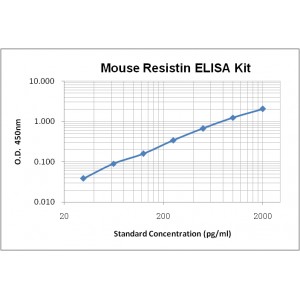More info
Assay Range | 31.2-2,000 pg/mL |
Sensitivity | 2.0 pg/mL |
Specificity | No cross-reaction with other related substances detected |
Size | 96T |
Storage | Store at 2 - 8ºC. Keep reconstituted standard and detection Ab at -20 ºC |
Assay Principle | Sandwich ELISA |
Sample Volume | 100 µL final volume, dilution factor varies on samples |
Detection Method | Chromogenic |
Kit Components
1. Recombinant Mouse Resistin standard: 2 vials
2. One 96-well plate coated with Mouse Resistin Ab
3. Sample diluent buffer: 12 mL - 1
4. Detection antibody: 130 µL, dilution 1:100
5. Streptavidin-HRP: 130 µL, dilution 1:100
6. Antibody diluent buffer: 12 mL x1
7. Streptavidin-HRP diluent buffer: 12 mL x1
8. TMB developing agent: 10 mL x1
9. Stop solution: 10 mL x1
10. Washing solution (20x): 25 mL x1
Background
Resistin, also known as Found In Inflammatory Zone 3 (FIZZ3) or adipocyte secreted factor (ADSF), C/EBP-epsilon-regulated myeloid-specific secreted cysteine-rich protein, cysteine-rich secreted protein A12-alpha-like 2, is a member of the Resistin-like molecules (RELMs) family which includes RELM-α/FIZZ1, RELM-β/FIZZ2 and RELM-γ. Mouse Resistin is synthesized as a 114 amino acid (aa) precursor containing a 20 aa signal sequence and a 94 aa mature protein. Mature mouse Resistin shows 34%, 42%, and 40% aa homology to mouse RELMα, β, and γ, respectively. Human and mouse Resistin share 53 % aa sequence identity and exhibit differences in expression patterns. Human Resistin has been shown to be expressed primarily in blood mononuclear cells, although it is also expressed in many other cells and tissues such as adipose tissues, pre-adipocytes, placenta, pancreatic islets, and primary leukemia cells.
Resistin knockout mice exhibit decreased fasting blood glucose levels as a result of reduced hepatic output, the biological activities of human Resistin, however, remain to be explored further. Although some studies demonstrate significant correlations between altered circulating Resistin levels and type 2 diabetes, insulin resistance, and/or obesity, others showed no correlation.


